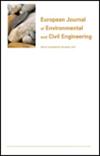高层建筑地聚合物混凝土蕴含能量与二氧化碳排放计算——以金奈市为例
IF 2.3
4区 工程技术
Q2 ENGINEERING, CIVIL
European Journal of Environmental and Civil Engineering
Pub Date : 2023-10-02
DOI:10.1080/19648189.2023.2260865
引用次数: 0
摘要
摘要本文研究了印度钦奈市高层(60 m高)住宅建筑中地聚合物混凝土(GPC)的总一次蕴含能(EE)和二氧化碳(CO2)排放量(ECO2e)。采用两种结构体系,采用相同的纵横比和荷载对建筑物进行了分析和设计;钢筋混凝土(RC)框架和剪力墙类型。计算了建筑面积、建筑体积和混凝土数量。结果表明,在相同等级的混凝土中,与常规混凝土(CC)相比,GPC的EE降低46%,ECO2e降低42%,成本降低7%。GPC剪力墙和框架结构在材料运输方面的一次能源消耗(EET)和二氧化碳排放(ECO2eT)比CC建筑低8%,相关成本低22%。与普通混凝土相比,GPC混凝土剪力墙和框架结构建筑的总初级建筑能效和ECO2e分别降低了46%和55%。从研究中可以看出,在高层结构中使用GPC比使用CC更环保。关键词:地质聚合物concretecarbon footprintembodied energyhigh-rise buildinglife周期analysisimpact分析AcknowledgementsThe作者感谢博士c . Boopalan结构顾问,M / s CBN咨询工程师,钦奈的有价值的合作和技术支持期间呈现数据。披露声明作者未报告潜在的利益冲突。数据可用性声明支持本研究结果的部分或全部数据、模型或代码可根据通讯作者的合理要求获得。本文章由计算机程序翻译,如有差异,请以英文原文为准。
Computation of embodied energy and carbon dioxide emissions of geopolymer concrete in high-rise buildings: a case study in Chennai city
AbstractThe total primary embodied energy (EE) and carbon dioxide (CO2) emissions (ECO2e) of geopolymer concrete (GPC) in high-rise (60 m height) residential buildings located at Chennai city, India, were carefully examined in this study. The buildings were analysed and designed with the same aspect ratio and loading with two structural systems; Reinforced concrete (RC) framed and Shear wall type. The computation was performed for floor area, building volume, and concrete quantity. The results show that for the same grade of concrete, compared with conventional concrete (CC), GPC's EE is reduced by 46%, ECO2e is reduced by 42%, and the cost is reduced by 7%. The primary energy consumption (EET) and CO2 emissions (ECO2eT) towards material transportation in GPC shear wall and framed structures are 8% lower and associated cost is 22% cheaper than CC buildings. Compared to CC, the total primary EE and ECO2e of GPC RC shear wall and framed buildings are 46 and 55% lower, respectively. From the study, it has been observed that GPC is more environmentally beneficial than that of using CC in high-rise structures.Keywords: Geopolymer concretecarbon footprintembodied energyhigh-rise buildinglife cycle analysisimpact analysis AcknowledgementsThe authors thank Dr. C. Boopalan, Structural consultant, M/s CBN Consulting engineers, Chennai for their valuable cooperation and technical support rendered during data.Disclosure statementNo potential conflict of interest was reported by the author(s).Data availability statementSome or all data, models, or code that support the findings of this study are available from the corresponding author upon reasonable request.
求助全文
通过发布文献求助,成功后即可免费获取论文全文。
去求助
来源期刊

European Journal of Environmental and Civil Engineering
ENGINEERING, CIVIL-ENGINEERING, GEOLOGICAL
CiteScore
4.80
自引率
4.80%
发文量
153
审稿时长
6 months
期刊介绍:
The European Research Area has now become a reality. The prime objective of the EJECE is to fully document advances in International scientific and technical research in the fields of sustainable construction and soil engineering. In particular regard to the latter, the environmental preservation of natural media (soils and rocks) and the mitigation of soil-related risks are now not only major societal challenges, but they are also the source of scientific and technical developments that could be extremely beneficial.
 求助内容:
求助内容: 应助结果提醒方式:
应助结果提醒方式:


